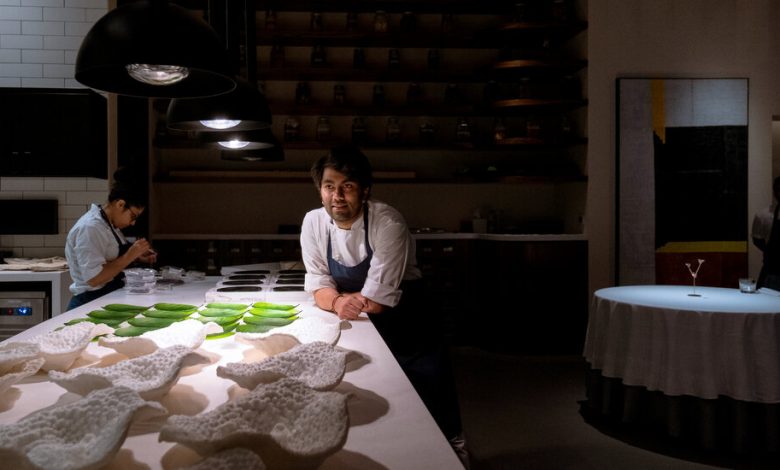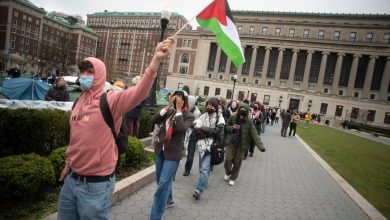Dubai Is the Newest Culinary Destination. Here’s a Taste.

In mid-September, on an artificial, palm tree-shaped island in the Persian Gulf, an avant-garde dinner service — “performance” is a better word — kicked off around 6 p.m. in a dimly lit restaurant on the roof of Dubai’s Nakheel Mall. Outside, the twilight call to prayer echoed off skyscrapers, construction sites and neighborhoods filled with low white villas.
Inside, electro music pulsed as servers initiated the nearly 20-course, 695-dirham (about $190) meal with postmodern panipuri, crispy pastry cups filled with palm hearts.
A succession of theatrical props and neo-Indian dishes followed: Cinnamon bark stuck with nuggets of baked crab. A glass teapot of mushroom broth to be poured over mushroom noodles. With great ceremony, servers deposited grilled pineapple, tomato broth and other dishes. Then the lights went out and “Fly Me to the Moon” filled the room. By the time the last course — white chocolate ice cream with Emirati honey — had been consumed, Frank Sinatra’s voice was fading away.
No, this wasn’t a scene from “The Menu” — the new movie that stars Ralph Fiennes as an exacting chef whose dinners are rife with drama — but rather the enactment of the nearly nightly experience at the new Tresind Studio restaurant.
Anyone wanting to clap for the director of this spectacle — a 36-year-old Indian chef named Himanshu Saini — had to hold their applause. At that moment, he was bound for Madrid to attend the Best Chef Awards ceremony, where he would be honored as one of the top 100 cooks on the planet.

The chef Himanshu Saini at Tresind Studio.Credit…Natalie Naccache for The New York Times
After years of simmering, the Dubai food scene is at full boil. The emirate now boasts some 13,000 establishments — more per capita than New York City — and local talents like Mr. Saini are nabbing global laurels.
This year, three top gastronomic guides released their first editions for Dubai, one of the seven city-states that makes up the United Arab Emirates.
The cascade began in February when the World’s 50 Best Restaurants unveiled its list for the Middle East and North Africa. Dubai snagged 16 slots, more than any other city, including the top honor, for the Japanese-influenced 3 Fils restaurant. Then, in June, France’s Gault & Millau held a gala for the release of its U.A.E. guide. A week later, the Michelin guide hosted its own ceremony to shower its stars on Dubai.
“Things have evolved so much,” said Gwendal Poullennec, the international director of Michelin guides, whose undercover inspectors began scouring Dubai in 2017. “There’s been a real explosion in the culinary scene.”
Credit goes partly to the emirate’s luxury hotels, which have long jockeyed to sign deals with Western and Asian boldface chefs — Gordon Ramsay, Heston Blumenthal, Alain Ducasse, Daniel Boulud, Heinz Beck, Bjorn Frantzen, Nobu Matsuhisa — and many top 2022 gastronomic prizes were claimed by hotel kitchens serving Continental cuisine: Stay by Yannick Alléno, Massimo Bottura’s Torno Subito, Ossiano at Atlantis, The Palm.
But the more impressive story is the surge of excellent homegrown establishments, like 3 Fils and Tresind Studio, whose chefs and owners actually carry an Emirati passport or residency card.
“When I arrived in 2009, we didn’t have homegrown restaurants. There were only chain restaurants, franchises and high-end restaurants in hotels,” recalled Stasha Toncev, who relocated from Serbia to work at the Armani Hotel and today runs her own “Balkan bistro,” 21 Grams. “Now there’s a huge difference.”
With such a dizzying array of dining options now available in Dubai, figuring out where to eat can be an overwhelming task for visitors eager to check out the new culinary scene. Here’s a guide to some of the most notable additions.
Dubai International Financial Center, or D.I.F.C., has blossomed over the last decade from a buttoned-down business center into a dining hub.Credit…Natalie Naccache for The New York Times
The flavor mall
Any epicurean exploration must begin at the Dubai International Financial Center, or D.I.F.C., a corporate complex that has blossomed over the last decade from a buttoned-down business center into a dining hub.
Besides housing banks, investment firms and property developers, the center houses restaurants by two pioneers who changed how and where Dubai eats: Omar Shihab and Izu Ani.
“We have double the number of restaurants here that we had three years ago,” said Mr. Shihab, the Jordanian-Emirati managing director of Boca, a Mediterranean restaurant that opened in the D.I.F.C. in 2014. “It’s crazy.”
Sporting a blazer and a pocket square, Mr. Shihab poured orange natural wine while a noisy after-work crowd filled the restaurant. In a few days, he said, the restaurant would host yet another event valorizing Dubai restaurants: the first Middle East edition of the Star Wine List’s awards.
The source of Boca’s local renown lay on the table before him: a menu of sustainable dishes — a phrase not commonly associated with a consumerist desert metropolis that offers year-round indoor skiing and an annual festival devoted to shopping.
Some menu staples, which range from 50 to 150 dirhams, feature Emirati ingredients, such as the “Garden in the Desert” salad, with local beetroot, desert plants, hydroponic tomatoes and edible flowers. Others are attempts to reduce food waste, like bread made from old sourdough loaves and tomato-skin powder.
The most innovative item on the menu isn’t something to eat but a QR code link to Boca’s carbon-emissions report, which Mr. Shihab ordered last year in his role as the restaurant’s chief sustainability officer.
The green wave is now spreading to places like Lowe, a chic restaurant in a desert compound that serves healthy global dishes — tangy tartare of Japanese pumpkin, leaf-wrapped fish with tomato jelly — and periodically hosts “Waste Not” dinners for 150 dirhams. Comprised of leftover food, these zero-waste banquets exemplify a new Dubai adage: One man’s trash is another man’s multicourse tasting menu.
Even newer, the recently revamped Teible restaurant features dishes concocted mainly from Emirati ingredients — no easy feat in a parched landscape. To wit: a 450-dirham set menu rife with shellfish from Fujairah, tomatoes from Ajman, corn from Al Ain and much else.
Around the corner from Boca, Izu Ani has been drawing diners to the D.I.F.C. since 2009. Born in Nigeria, raised in England and trained in Michelin-starred kitchens in France, he arrived in Dubai to help launch a D.I.F.C. branch of La Petite Maison, a southern French restaurant popular in London. It was an overnight success, and he went on to create his own Dubai restaurants. Last year, Esquire magazine’s Middle East edition put “Chef Izu” on the cover and declared him “Dubai’s first celebrity chef.”
“You know the nickname for the D.I.F.C., right?” Mr. Ani joked as Dubai’s glamorous set filled the boisterous dining room of Alaya, his new Middle Eastern restaurant. “The Dubai International Food Court!”
Known for his signature flat-cap and gameshow-host smile, Mr. Ani deserves a lot of the credit, from his Chinese-influenced Shanghai Me to Gaia, his modern Greek taverna, which placed 10th on the new Top 50 list.
On a balmy Friday night, a crowd of social media influencers, expats, Emirati men in white dishdashas, and women with kohl-ringed eyes were packed around Alaya’s big round tables. Servers delivered modern takes on Mideast dishes — rigatoni pasta with zaatar (125 dirhams), hay-smoked yellowtail dusted with sumac and Turkish chiles (160 dirhams).
When he arrived in Dubai, Mr. Ani said, he didn’t plan to stay long, but the U.A.E. won him over.
“I have to pay respect to a country that has welcomed me and given me a chance to grow,” he said, confiding that, as a kid, he had been considered “a nothing who would go to prison.”
Here, he said, “the philosophy is ‘Everything is possible.’”
Modern morsels and Mideast memories
As a child, Solemann Haddad’s favorite Dubai restaurant was Chili’s, that American temple of greasy roadhouse grub.
Now the tattooed 26-year-old chef, winner of the Future Great honor from the Gault-Millau restaurant guide and the Young Chef Award from Michelin, runs one of the emirate’s most sought-after restaurants, Moonrise, an eight-seat glass box atop a 30-story apartment building.
“Chili’s was the benchmark,” he recalled, sitting on Moonrise’s outdoor terrace as the sun cast its last rays on nearby luxury-hotel towers. “There was almost literally nothing then.”
Curiosity soon seized Mr. Haddad, the son of a Syrian father and a French mother, and he discovered backstreet joints serving Pakistani, Indian and other far-flung cuisines.
“It’s very much a reflection of the things that I ate growing up and a reflection of the cuisines all around Dubai,” he said, describing Moonrise’s menu. “French, Syrian and Middle Eastern techniques are only useful to me to the extent that they allow me to say the story of Dubai through food.”
Minutes later, he was assembling the opener on Moonrise’s 650-dirham tasting menu — a panipuri of foie gras blended with white chocolate and date syrup and topped with Szechuan chile oil — for several elegant young Emirati women.
The flavor-packed mini-sculptures took off from there. Some were childhood reminiscences, like the blowtorch-toasted, grilled-cheese sandwich. A tribute to the first thing he ever cooked, his grown-up version used Japanese milk-bread from a local bakery, aged Parmesan, black garlic and a fine disc of black truffle.
Other dishes were nods to bygone Dubai food trends. Riffing on spicy tuna sushi, which Mr. Haddad said had been ubiquitous in Dubai two decades ago, he mixed a mound of diced yellowtail flavored with Syrian shatta (a fermented chile paste) and topped it with black “caviar” crafted from truffle juice and Syrian peppers.
Later, as he served the evening’s coda — a strawberry tart made with Basque cheesecake, white-chocolate ganache and brown-butter crumble — Mr. Haddad recalled the tarts he ate as a child. “They were at every wedding, every anniversary, every ceremony,” he said.
Syria, revisited
Some years ago, the Syrian television chef Mohamad Orfali attempted to teach his audience on the Fatafeat channel how to cook modernized Middle East classics. The response was swift — and furious — from culinary traditionalists.
“When people saw me at the mall, they shouted at me!” the 41-year-old recalled one afternoon as he sat in the airy dining room of Orfali Bros. Bistro, which he opened in 2021 with his pastry-chef siblings, Wassim and Omar.
The experience reminded him how much some Middle Easterners are attached to culinary classics. But Mr. Orfali, who has lived in Dubai since 2007, was intent on updating the recipes, particularly those from his native city of Aleppo, which he last saw a dozen years ago.
“The cuisine of Aleppo is a diamond, but it has a lot of dust on it,” said Mr. Orfali, a burly, bearded fellow wearing a plaid shirt and glasses.
Exhibit A is the restaurant’s version of his hometown’s most famous dish, the kebab bil karaz, or cherry kebab (95 dirhams). “Traditionally we grill the meatballs, then we cook them in the sour cherry sauce,” he said. “But the sour cherry overpowers everything, and the bread gets soggy.”
Instead, Mr. Orfali uses yakitori-like skewers and Wagyu meatballs and reduces the sauce to ketchup-like thickness. To avoid offending diners who love the classic recipe, Mr. Orfali changed the name — his take is called “Come With Me to Aleppo.”
His famous Corn Bomb, inspired partly by hot-corn sellers in Aleppo, is a crunchy flat tortilla piled with globs of emulsified corn juice and topped with shaved Parmesan and huitlacoche corn fungus (29 dirhams).
Still, he insists that Orfali Bros. is not a Middle Eastern restaurant. With offerings that include Korean chicken wings (59 dirhams) in gochujang glaze and a caviar-drenched beignet filled with Russian smetana cream (99 dirhams), the menu swoops across the map.
“I have different ingredients from around the world,” Mr. Orfali said, “and I make it all mine.”
The soul of Dubai
When he is not cooking, Mr. Orfali often seeks out the sunny interiors of Stasha Toncev’s 21 Grams. Tucked atop a small commercial center in a residential neighborhood, the restaurant-cafe is a favorite hangout of cooks and restaurateurs. On a given day, you might spot Mr. Shihab from Boca; Carlos De Garza, the executive chef of Teible; or perhaps Hattem Mattar, the self-proclaimed “First Arab pitmaster” behind the Mattar barbecue joint at the new Time Out Dubai food hall.
That 21 Grams even exists is a small miracle.
“Everyone told me I was crazy!” Ms. Toncev said of her declaration, in 2016, that she planned to pursue her dream of opening a southeastern European restaurant in Dubai.
“Everyone said, ‘How are you going to make sarma and cevapi likable and attractive?’” she said, naming the traditional stuffed cabbage leaves and sausages that the restaurant now serves.
But Ms. Toncev — a gregarious 40-year-old who favors leather pants and Birkenstocks — soldiered on. In 2018, she launched the restaurant in a smaller nearby location, and in 2019, it was declared “Indie Restaurant of The Year” by the local What’s On magazine. This year, it snagged “Best European Restaurant” honors from Time Out Dubai.
In addition to cevapi (88 dirhams) and sarma (68 dirhams), the restaurant’s chef, Milan Jurkovic, glides from comfort foods like pljeskavica — a meat patty upgraded with Wagyu beef — to fresh produce like Serbian beetroot salad (52 dirhams), which he morphs into a tender, thin-sliced carpaccio sweetened with blackberry sauce and brown butter.
Part of the restaurant’s appeal is the warm décor: Vintage kilims. Red apples on the tables. Books. The other ingredient is Ms. Toncev herself, who greets regular guests with kisses, hugs her staff and organizes “Balkan Soul Music Night” concerts.
“A big part of Balkan culture is hospitality,” said Ms. Toncev, who at age 9 began cooking meals for children in her neighborhood back in Serbia.
Sitting beside windows overlooking the Burj Al-Arab hotel, she mused on her decision to hatch her “crazy” scheme in this Middle East metropolis.
“I strongly believe that in life you have to always dig deeper,” she said as jazz music and lively chatter filled the room. “In Dubai, if you dig deeper, you will find a soul.”
Follow New York Times Travel on Instagram, Twitter and Facebook. And sign up for our weekly Travel Dispatch newsletter to receive expert tips on traveling smarter and inspiration for your next vacation. Dreaming up a future getaway or just armchair traveling? Check out our 52 Places for a Changed World for 2022.




